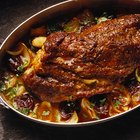
You can save money without sacrificing flavor or texture by buying inexpensive pork neck fillets and cooking them properly. Although the fillets are too tough for pan-frying or any quick-cooking methods, if you cook them low and slow, using indirect grilling methods or by slow and gentle moist braising, you can create a succulent main dish without spending as much as you would for pricier cuts such as tenderloins.
Grilling Pork Neck Fillets
Step 1
Set your grill up for indirect cooking. If you're using a charcoal grill, place a drip pan in the middle of the grill with an even amount of coals on either side. If you're using a gas grill, preheat the grill with all the burners on high before turning on one burner for a two-burner grill or the middle burner for a three-burner grill.
Step 2
Pat the pork neck fillet dry with paper towels before drizzling it with cooking oil and seasoning it with your favorite spices. In addition to salt and pepper, you can add ground cumin, garlic or any of your favorite herbs. Rub the seasonings over the pork neck fillet.
Step 3
Place the fillet on the unheated part of the grill. Cook the pork for roughly one hour per pound, turning the fillet once.
Step 4
Check the pork neck fillet for doneness by inserting an instant-read thermometer in the thickest part. When the internal temperature reaches at least 145 degrees Fahrenheit, the pork is safely cooked.
Step 5
Remove the pork neck fillet from the grill and place it on a platter. Cover it loosely with foil and let the pork rest for roughly 20 minutes before slicing and serving.
Braising Pork Neck Fillets
Step 1
Grab a heavy-bottomed pot that can accommodate the pork neck fillet. Place it on the stove and turn the heat to high. Once you can feel the heat by passing your hand over the bottom of the pot, add your cooking oil.
Step 2
Season the pork with salt and pepper and add it to the pan once the oil is shimmering. Brown all sides of the pork, which usually takes roughly 10 to 15 minutes.
Step 3
Pour wine, broth or another type of cooking liquid into your pot. There should be enough liquid to reach the top of the pork.
Step 4
Add any aromatic vegetables or herbs that you'd like to use. Some examples include onion, garlic, juniper berries or bay leaves.
Step 5
Bring the pot to a simmer before covering it and turning the heat to low. Let the pork cook for about 3 to 4 hours, turning it occasionally.
Step 6
Remove the pork from the pot once it is very tender and an instant-read thermometer reads at least 145 degrees F.
Related Articles

How to Braise Pork

How to Cook Pork in a Skillet

How to Cook Pork Tenderloin With ...

How to Cook Pork Chops on an Electric ...

How to Cook Marinated Pork Loin From a ...

How to Cook With Pork Jowl

How to Use a Roaster for Pork

How to Cook Smoked Pork Knuckles

How to Cook a Neck Roast

How to Cook Neck Bones & Pig Feet

How to Cook a Frozen Pork Fillet in the ...

How to Cook a Moist & Tender Center Cut ...

How to Cook Pulled Beef Without a Slow ...

How to Cook the Neck of a Deer

How to Make a Juicy Pork Tenderloin

Roasting Instructions for a Half Loin ...

How to Cook Pork Pinwheels

Are Pork and Beans a Good Source of ...

How to Grill Rack of Lamb

How to Make Pulled Pork In A Slow Cooker
References
Tips
- Add the browned pork neck fillet to your slow cooker along with seasonings and cooking liquid to let the pork neck braise in your slow cooker for 4 hours on high.
Writer Bio
Caryn Anderson combines extensive behind-the-scenes writing experience with her passion for all things food, fashion, garden and travel. Bitten by the travel bug at the age of 15 after a trip to Europe, Anderson fostered her love of style and fashion while living in New York City and earning her degree at New York University.
Photo Credits
Digital Vision./Photodisc/Getty Images